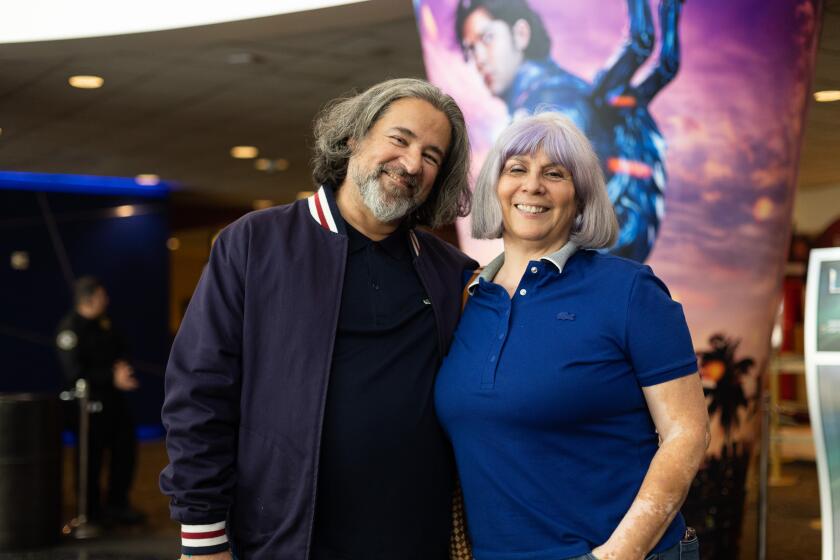
This story contains minor spoilers.
“Blue Beetle,” the first live-action superhero film starring a Latino lead, took the top spot at the box office this weekend thanks in large part to Latino audiences — per Warner Bros., they accounted for 39% of tickets bought.
‘None of us are as strong as all of us.’ Xolo Maridueña’s family, friends rally behind ‘Blue Beetle’
Xolo Maridueña can’t promote ‘Blue Beetle’ because of the Hollywood labor dispute. But his family, friends and Latino community groups are spreading the word.
The embrace of the Warner Bros. and DC Studios movie by its target audience could be partially attributed to its cultural specificity.
“Blue Beetle” stars Xolo Maridueña as Jaime Reyes, a recent college grad from a Mexican American household who develops a symbiotic relationship with an alien scarab that gives its host superpowers. The movie was directed by Ángel Manuel Soto, who is from Puerto Rico, and written by Gareth Dunnet-Alcocer, a native of Queretaro, Mexico.
‘Blue Beetle’ director Angel Manuel Soto talks about the movie’s Latinx roots, its music and the ongoing strikes.
The duo was granted the creative freedom to pull from their own version of Latinidad to inform what’s on screen. The end result is a film laden with pop cultural references from Latin America, as well as nods to its history.
The infamous School of the Americas, for example, makes an appearance in the movie. The former U.S. military center was founded in 1946, and it was where Latin American soldiers were trained to carry out American interventionist operations across the region (including coups in Guatemala and Chile). It’s where the movie’s villain, Carapax (played by Raoul Trujillo), becomes a ruthless mercenary.
On a lighter note, the soundtrack features plenty of instantly recognizable hits from across Latin music. The unmistakable clarinet opening to the now-defunct Puerto Rican duo Calle 13’s “Atrévete-Te-Te” welcomes us to the fictional Palmera City.
Mexican singer-songwriter Chalino Sánchez’s song about the death of his brother, “Armando Sánchez,” plays while Rudy (George Lopez) waits inside his Tacoma truck, as if foretelling what’s to come. And Argentine rock band Soda Stereo’s groovy “Nada personal” closes out the film.
There are also several Latino films and TV shows referenced in “Blue Beetle.” Most of these first appear early in the film during a sequence featuring Nana (Adriana Barraza), Jaime Reyes’ grandmother who may or may not be a former Zapatista.
“For the most part, Latinos can connect with the fact that we were either forced to watch something, or we grew up watching something,” Soto told De Los of the scene.
“We had that opportunity in the movie, where Nana is flipping channels, so for us it was like, ‘Okay, what were we watching when we were in our house?’”
Here’s a short list of movies and television shows from Latin America that made it into “Blue Beetle.”
María la del Barrio (1995)
This is the third installment in the world-famous trilogy of telenovelas with protagonists named María that Mexican singer and actress Thalia starred in throughout the 1990s (“María Mercedes” and “Marimar” being the other two). The María here is a woman from an impoverished neighborhood in Mexico City who falls in love with a wealthy man. The melodrama is perhaps best remembered for Soraya Montenegro (played by Itatí Cantoral), a deranged antagonist who now populates scores of Mexican memes. In “Blue Beetle,” the Reyes family teasingly sings the opening theme song to Jaime, referencing the social class difference between him and Jenny, the hero’s love interest.
Where to watch: ViX
Cronos (1992)
Guillermo del Toro’s debut feature remains one of Latin America’s most celebrated genre achievements 30 years after its original release. A shot of the golden scarab-shaped device, which injects a mysterious substance into an elderly man turning him into a vampire, pops up in “Blue Beetle.” Furthermore, the alien contraption that transforms Jaime into a superhuman with insectlike attributes closely resembles this mechanism in Del Toro’s first masterwork.
Watch it on: Max
Macario (1960)
Set during the Día de Muertos celebration, this 1960 classic from director Roberto Gavaldón became the first Mexican production to earn an Oscar nomination for Best Foreign Language Film (as the category was known then). In that movie’s most emblematic sequence, Macario (Ignacio López Tarso), a humble peasant who’s befriended Death itself, enters a cave paved with candles that symbolize humanity’s souls. Not only do we see a glimpse of that moment on the Reyes family’s TV in “Blue Beetle,” but the scene is also replicated during Jaime’s touching encounter with his deceased father Alberto (Mexican acting legend Damián Alcázar) in the afterlife.
Where to watch: ViX
El Chapulín Colorado (1973-1979)
When comedian Felipe Esparza (playing a security guard) takes a look at the CCTV screens during a climactic sequence in “Blue Beetle,” we get to enjoy an homage to the stop motion intro of “El Chapulín Colorado.” Created by Roberto Gómez Bolaños (also the man behind “El Chavo del Ocho”), the comedy series followed the misadventures of a bumbling but kindhearted superhero dressed in a bright red and yellow grasshopper costume. Although it originally aired during the 1970s, the series gained multiple generations of fans thanks to reruns over the subsequent decades. If you stick around after the full credits roll, you’ll get to take a closer look at the animated sequence.
Where to watch: not available for streaming.
Sábado Gigante (1962-2015)
Hosted by Chilean personality Mario Kreutzberger under the stage name of Don Francisco, this variety show ran every Saturday night for over five decades and became a staple in Latino households, both in the U.S. and across Latin America. Its final broadcast aired in 2015, and the program went off the air with the notable distinction of being the world’s longest-running TV variety show. The specific clip in “Blue Beetle” shows Don Francisco and a hooded character known as El Chacal (a sort of Medieval executioner) who would sound his trumpet as a way to humorously eliminate contestants from a singing competition segment within the three-hour long program.
Where to watch: not available for streaming.
Fidel Martinez contributed to this report.
More to Read
The Latinx experience chronicled
Get the Latinx Files newsletter for stories that capture the multitudes within our communities.
You may occasionally receive promotional content from the Los Angeles Times.









